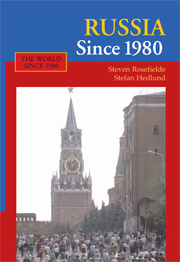Introduction
Published online by Cambridge University Press: 05 June 2012
Summary
The collapse of the Soviet Union was “the greatest geopolitical catastrophe of the 20th century.”
Vladimir Putin, April 24, 2005The year 1980 can be viewed as the beginning both of the end of Soviet communism and a time of turbulent Russian transformation. The era that ensued began on a humdrum note with Soviet declarations of socialist superiority, tempered by concerns about the changing correlation of forces, and western expectations of Kremlin muddling through with no appreciation that the economy might have entered a period of protracted stagnation. And it continued through what can be called Vladimir Putin's imperial authoritarian restoration. In between, the Communist Party of the Soviet Union, which oversaw a socialist centrally planned, authoritarian martial police state, tried to liberalize, modernize, and partly westernize by adopting Mikhail Gorbachev's ambitious program of glasnost (political candor), demokratizatsia (democratization), uskorenie (GDP growth acceleration), perestroika (radical economic reform), and novoe myslennie (new thinking to end the cold war). Although widely heralded at home and abroad, these programs contributed variously to an acute economic depression, the destruction of communist power, and the dissolution of the USSR into fifteen independent republics, culminating in the Kremlin's loss of 30 percent of its territories and 48 percent of its population.
The post-Soviet years were similarly convulsive. Boris Yeltsin, Russia's first postcommunist president, undaunted by the results of Gorbachev's Muscovite liberalization, chose an even more extreme course mislabeled perekhod (radical market transition), which purportedly sought to expand the scope of late Soviet era business, entrepreneurship, and private property with shock therapeutic methods, to open the economy to globalization, and forge a multiparty democracy.
- Type
- Chapter
- Information
- Russia Since 1980 , pp. 1 - 6Publisher: Cambridge University PressPrint publication year: 2008

